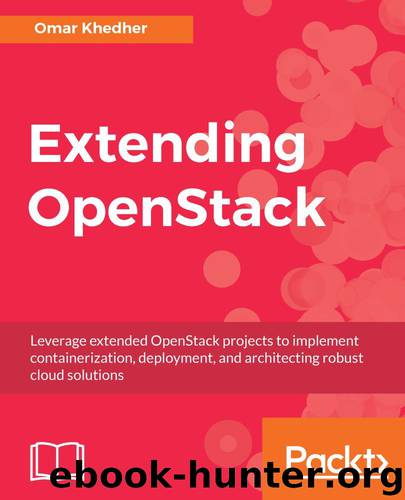Extending OpenStack: Leverage extended OpenStack projects to implement containerization, deployment, and architecting robust cloud solutions by Omar Khedher

Author:Omar Khedher [Khedher, Omar]
Language: eng
Format: epub
Tags: COM043000 - COMPUTERS / Networking / General, COM048000 - COMPUTERS / Systems Architecture / Distributed Systems and Computing, COM088000 - COMPUTERS / System Administration / General
Publisher: Packt Publishing
Published: 2018-02-27T00:00:00+00:00
Neutron HA – VRRP
The other way of handling high availability of the network service in OpenStack is based on the concept of VRRP. Unlike legacy and DVR-based routers, using VRRP has different requirements, as follows:
VRRP groups set up for virtual routers
Multiple network nodes
An additional dedicated network for high availability traffic
Designation of master and slave routers using virtual IPs
In a VRRP setup, a master router is configured with a virtual IP (VIP) that represents the next route hop acting as the default IP address for the routers pool. The network traffic load can also be spread amongst the available routers within the VRRP router group that can be configured based on the scheduler mechanism in the master router. In case of a failover event, a new master router will be elected and set as active. The VIP will be associated to the new master and immediately starts handling routing decisions.
It is important to note that the active/standby routers use the following essential terminologies to achieve a successful failover event:
Priority: An assigned router with the highest priority is marked as master. The priority range in a VRRP router group starts from 0 up to 255. The highest priority is 255.
Preemptive election mode: In case of a failed master router, the latter can be reassigned to resume its activity again if it is associated with the highest priority in the VRRP router group.
Non-preemptive election mode: An active router keeps operating as master although the presence of a backup router with highest priority was assigned during a normal operational network exercise. Switching to a new master occurs only if the currently active master fails.
Preemptive delay timer: The waiting time before starting an election for a new master.
Advertisement interval timer: The active router keeps informing the standby routers within the same VRRP router group about its health state. If backup routers do not receive an indication of state from the master once in a window of X times, a new election process will be started by sending VRRP advertisements and priority selection.
Download
This site does not store any files on its server. We only index and link to content provided by other sites. Please contact the content providers to delete copyright contents if any and email us, we'll remove relevant links or contents immediately.
Grails in Action by Glen Smith Peter Ledbrook(9165)
Sass and Compass in Action by Wynn Netherland Nathan Weizenbaum Chris Eppstein Brandon Mathis(8808)
Azure Containers Explained by Wesley Haakman & Richard Hooper(7444)
Configuring Windows Server Hybrid Advanced Services Exam Ref AZ-801 by Chris Gill(7436)
Kotlin in Action by Dmitry Jemerov(7263)
Running Windows Containers on AWS by Marcio Morales(6988)
Microsoft 365 Identity and Services Exam Guide MS-100 by Aaron Guilmette(5402)
Microsoft Cybersecurity Architect Exam Ref SC-100 by Dwayne Natwick(5213)
Combating Crime on the Dark Web by Nearchos Nearchou(4982)
The Ruby Workshop by Akshat Paul Peter Philips Dániel Szabó and Cheyne Wallace(4671)
Management Strategies for the Cloud Revolution: How Cloud Computing Is Transforming Business and Why You Can't Afford to Be Left Behind by Charles Babcock(4527)
Python for Security and Networking - Third Edition by José Manuel Ortega(4234)
The Age of Surveillance Capitalism by Shoshana Zuboff(4210)
Learn Wireshark by Lisa Bock(4123)
The Ultimate Docker Container Book by Schenker Gabriel N.;(3888)
Learn Windows PowerShell in a Month of Lunches by Don Jones(3681)
DevSecOps in Practice with VMware Tanzu by Parth Pandit & Robert Hardt(3569)
Windows Ransomware Detection and Protection by Marius Sandbu(3543)
Blockchain Basics by Daniel Drescher(3507)
